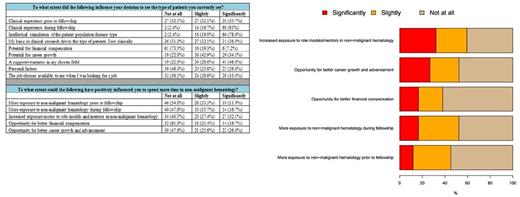Abstract
Background: Non-malignant hematologic conditions are extremely prevalent and contribute significantly to the global burden of disease. Most training programs in hematology are combined with training in medical oncology, and there is no longer a specific requirement for a certain amount or percentage of fellowship time to be dedicated to training in non-malignant hematology. As a result, our health care system may soon face a shortage of specialists in non-malignant hematology. We sought to identify factors that lead hematology-oncology fellows to pursue (or not to pursue) careers in non-malignant hematology.
Methods: We conducted a cross-sectional web-based survey of our institution's hematology/oncology graduates from 1998 through 2016. Of 164 alumni, 151 had available contact information. We emailed all 151 alumni and received 2 "bounceback" emails indicating the email on file was no longer valid, leaving a total of 149 alumni who were emailed the questionnaire.
Results: Of the 149 alumni emailed the questionnaire, 86 responded (response rate 57.7%). The median age of the responders was 44 years (range 33-63) and 62 (72.1%) were male. 59 (68.6%) of respondents practice at an academic medical center, 24 (27.9%) in a community center or private practice, and 3 (3.5%) are in other areas (industry, government, etc). Respondents reported spending a median of 65% of their time in clinical practice, 12.5% in research, 2.0% in education, and 5.0% in administration. Those in clinical practice reported spending a median of 60% of their time in solid tumor oncology, 20% in hematologic malignancies, and 5% in benign hematology. 46 (54.8%) of respondents indicated that they spent at least some time practicing non-malignant hematology, but only 1 respondent reported spending more than 50% of their time seeing patients with non-malignant hematologic conditions. Factors affecting choice of patient population are shown in the top component of the Table. For those who did not report practicing non-malignant hematology, the bottom component of the Table and the Figure show the degree to which respondents indicated that each of these factors could have positively influenced them to pursue a career in non-malignant hematology. Overall, respondents involved in clinical practice reported a median job satisfaction level of 85 on a scale of 1-100. Those who practice non-malignant hematology reported a slightly but non-significantly lower job satisfaction rate as compared to those who do not practice non-malignant hematology (median 81.5 versus 87.0, p=0.14), but there was no correlation between the percentage of time spent on non-malignant hematology and reported job satisfaction amongst those practicing non-malignant hematology (Spearman correlation = 0.05, p=0.75).
Conclusions: Graduates of an academic hematology-oncology fellowship spend over 50% of their time in clinical practice, but only about half spend at least some time practicing non-malignant hematology and almost none practice non-malignant hematology for a majority of time. Factors most influencing graduates' career choices include clinical experience during fellowship, intellectual stimulation of the patient population/disease type, and a supportive mentor. Graduates report that the factor most likely to have led to spending more time in non-malignant hematology would be increased exposure to role models and mentors in this area. Overall, graduates report being satisfied with their careers.
No relevant conflicts of interest to declare.
Author notes
Asterisk with author names denotes non-ASH members.


This feature is available to Subscribers Only
Sign In or Create an Account Close Modal